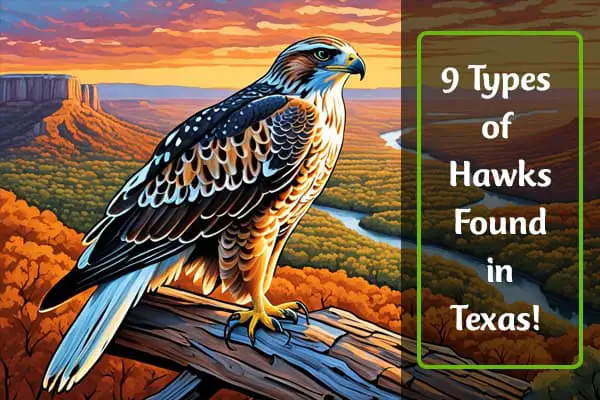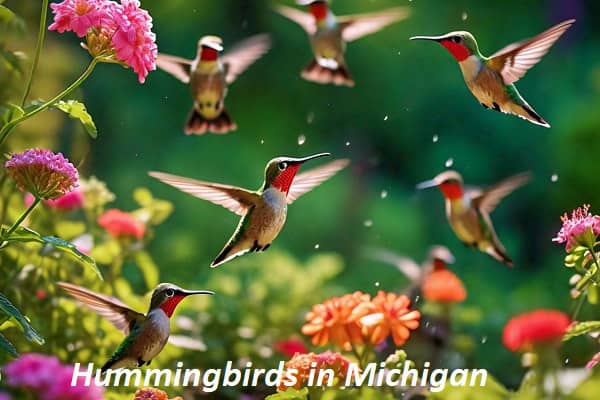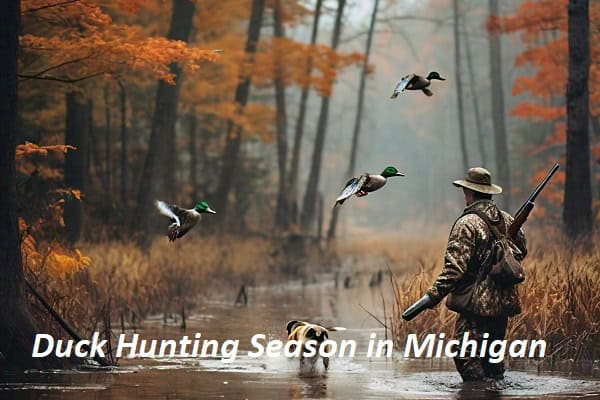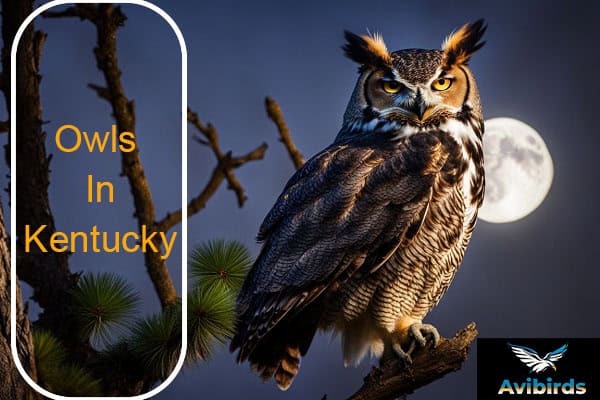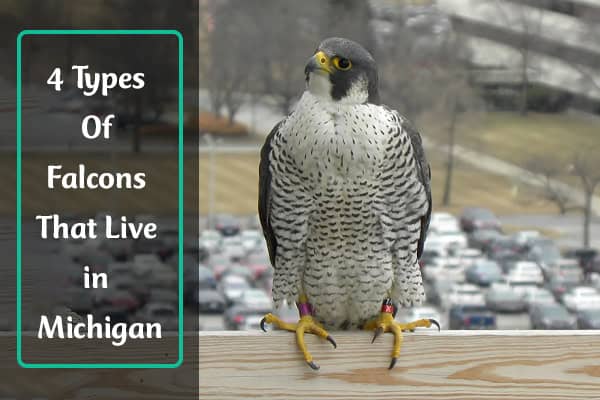9 Types Of Finches in Illinois (With Pictures)
Are you fascinated by the bright colors and beautiful songs of finches in Illinois? If yes, you’re in for a treat. We’ll dive into the world of finches in Illinois. You’ll learn about the American Goldfinch and the House Finch, among others. These birds add magic to Illinois with their looks and behaviors.
What hidden finches might be in your backyard? Get ready to be amazed as we reveal their secrets. This guide is perfect for bird lovers and nature enthusiasts. It will take you on an exciting journey to discover the finches of Illinois.
Finches in Illinois
Illinois is a haven for finches, with many species found throughout the state. From the bright American Goldfinch to the rare White-Winged Crossbill, these birds live in various places. Urban areas like Champaign and Urbana have more finch types than rural spots. This shows how important parks, gardens, and backyards are for these birds.
Illinois is home to 9 finch species, some that stay all year and others that visit in winter. Bird lovers can see many different finches, like the American Goldfinch, House Finch, and Purple Finch, every year.
| Finch Species | Population Estimate | IUCN Red List Status |
|---|---|---|
| American Goldfinch | 42 million | Least Concern |
| House Finch | 500 million | Least Concern |
| Purple Finch | Stable or Decreasing | Least Concern |
| White-Winged Crossbill | N/A | Least Concern |
| Evening Grosbeak | Steep Decline | Vulnerable |
Exploring Illinois’s finches shows the state’s natural beauty and teaches us about these birds. Whether you love birdwatching or just enjoy nature, learning about Illinois’s finches is both fun and enlightening.
1. American Goldfinch
- Scientific name: Spinus tristis
- Life span: 3-6 years
- Size: (11-13 cm)
- Weight: (11-20 g)
- Wingspan: (19-22 cm)
The American goldfinch is a vibrant finch found in Illinois. It has a unique peak-shaped bill and acrobatic flight. This finch brightens up gardens and fields with its color.
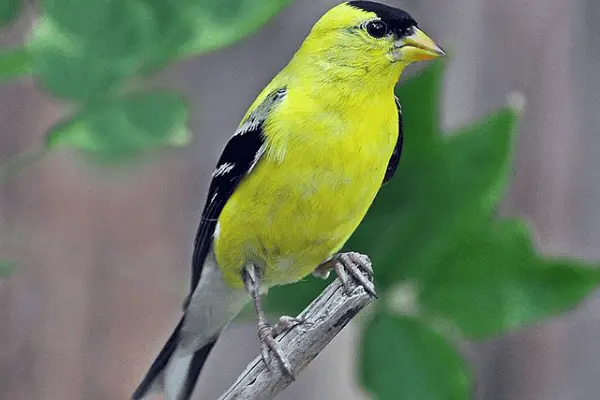
Identifying Features and Behavior
In summer, the male American goldfinch is bright yellow. In winter, it turns olive brown. These finches love to be together and make beautiful sounds. Males show off their colors and calls to attract females and scare off rivals.
Habitat and Diet
These finches eat seeds from thistles, sunflowers, and more. They visit backyard feeders often. Illinois is home to millions of them, but their numbers have dropped by 27% in the last 50 years.
Fun Facts About the American Goldfinch
- The American goldfinch is the state bird of Iowa and New Jersey.
- It is one of the last songbirds to begin nesting in the summer, with females laying 2-7 eggs in mid-summer.
- Despite being a seed-eating species, the American goldfinch is vulnerable to the parasitic Brown-headed Cowbird, which lays its eggs in goldfinch nests along with 220 other species.
- Nestlings of the American goldfinch survive better due to the lack of competition for food with Brown-headed Cowbird chicks.
The American Goldfinch is a joy to watch with its bright colors and lively behavior. Keep an eye out for these finches as you enjoy the outdoors. They add a special touch to Illinois.
2. House Finch
- Scientific name: Haemorhous mexicanus
- Life span: 10 years
- Size: (13-14 cm)
- Weight: (16-27 g)
- Wingspan: (20-25 cm)
The house finch is a vibrant bird often seen in Illinois’s residential areas. It has a bright red or orange head, chest, and rump. This finch loves both urban and suburban life, making it a favorite among bird watchers.
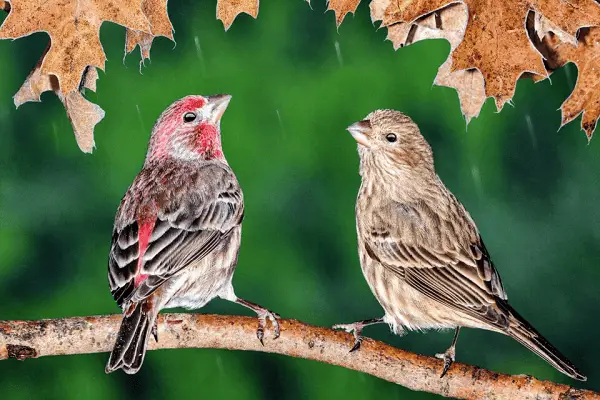
Appearance and Identification
The house finch stands out with its mix of colors. Its body is brown, but its head, chest, and rump shine with red or orange. Females have a more muted brown look but still have a unique, finch-like shape.
Adaptability and Range
The house finch is incredibly adaptable. It has moved into many new places, including homes, parks, and gardens. These birds are often seen near people in Illinois, visiting bird feeders or singing in the morning.
They are monogamous and stay with their mates, forming strong bonds. This social behavior helps them thrive in cities across Illinois.
3. Purple Finch
- Scientific name: Haemorhous purpureus
- Life span: 3-7 years
- Size: (12-16 cm)
- Weight: (18-32 g)
- Wingspan: (22-26 cm)
As the sun dances through the vibrant foliage, one bird stands out in Illinois: the captivating purple finch. This migratory species visits the state in spring and summer. It brings elegance to the woodlands and forests.
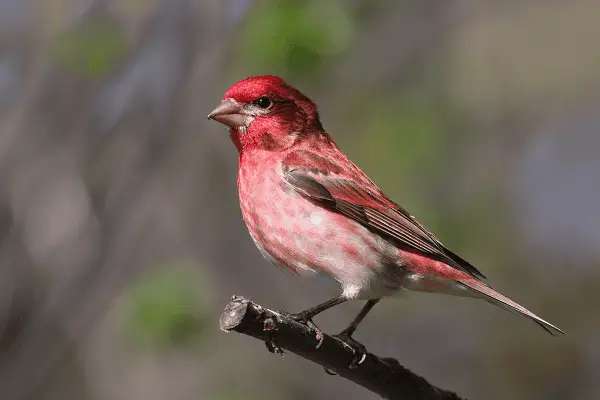
Distinguishing Characteristics
The purple finch is known for its striking look. Males have a rosy-red head, chest, and back. Females have brown feathers with streaks. These differences make spotting them a fun challenge for bird lovers.
Courtship Displays and Vocalizations
The purple finch has fascinating courtship behavior. In spring, males show off to attract females. They hop and flutter around them. They also make a variety of sounds, including a warbling song and a high-pitched call.
The purple finch is a true gem of Illinois skies. With an eye for detail and patience, you can see these elegant birds migrate through the state. They add wonder to birdwatching adventures.
4. White-Winged Crossbill
- Scientific name: Loxia leucoptera
- Life span: 4 years
- Size: (15-17 cm)
- Weight: (24-26 g)
- Wingspan: (26-28 cm)
During irruption events, the White-Winged Crossbill sometimes visits Illinois. It has a special crossed bill for getting seeds out of pinecones. This bird lives in the coniferous forests of North America but goes further to find food.

Unique Beak and Foraging Behavior
This finch is about 5.5 inches long and has a special bill. Its crossed bill helps it open pinecones to get the seeds. This skill lets it live in the coniferous forests.
Irruption Years and Sightings
When irruption events happen, bird lovers in Illinois can see these seed-eating finches. They come to Illinois when there are lots of pinecones in their usual area. Seeing them is exciting for nature fans.
“The arrival of the White-Winged Crossbill among the bird species in Illinois occurred early in the year, alongside other species documented in January.”
| Interesting Facts About the White-Winged Crossbill |
|---|
|
5. Evening Grosbeak
- Scientific name: Hesperiphona vespertina
- Life span: 3-4 years
- Size: 16 to 22 cm
- Weight: 38.7 to 86.1 g
- Wingspan: 30 to 36 cm
If you love birds in Illinois, you might see the amazing evening grosbeak. This finch is known for its bright colors and big bill. They visit Illinois rarely, but when they do, it’s a big deal for bird fans.

Appearance and Identifying Features
The evening grosbeak stands out. Males are bright yellow with black wings and a special black crown. Females are grayish-yellow. Their big, thick bill is perfect for eating seeds and fruits.
Spotting Tips and Habitats
To see the evening grosbeak in Illinois, look for big groups near fruit trees or bird feeders with high-energy foods. They live in places with coniferous forests, like Shawnee National Forest or Starved Rock State Park. Seeing these rare finches is a special treat for nature lovers.
“The evening grosbeak is a true gem of the Illinois skies, with its striking appearance and captivating behavior. Catching a glimpse of these rare finches is a birding experience that will linger long in the memory.”
6. Pine Siskin
- Scientific name: Spinus pinus
- Life span: 5-9 years
- Size: (11-14 cm)
- Weight: (12-18 g)
- Wingspan: (18-22 cm)
If you love birds in Illinois, watch for the Pine Siskin. This small finch lives in the state all year, adding color to the landscape. It has streaked brown feathers and yellow on its wings and tail.
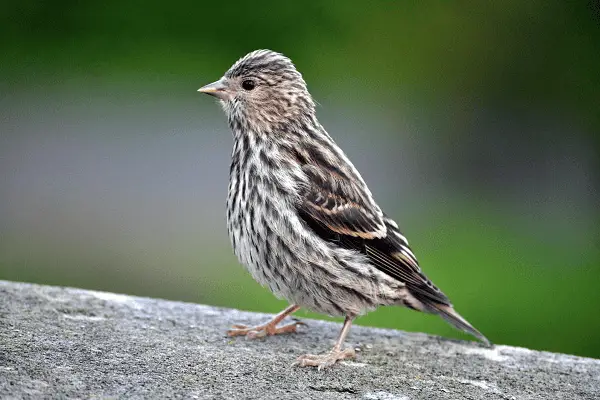
Pine Siskins are small but adaptable, eating seeds from many trees and thistle from feeders. They are known for their quick flight through woods and open areas.
Seeing Pine Siskins is fun because they are lively. They move in groups, making sounds as they go. Their call is unique, adding to Illinois’ bird sounds.
Whether in the wild or at your feeder, the Pine Siskin is a treat for bird lovers in Illinois. Their adaptability, bright feathers, and active nature make them a joy to watch.
| Characteristic | Description |
|---|---|
| Size | Slightly smaller than American Goldfinches, around 5 inches in length |
| Appearance | Streaked brown plumage with yellow edgings on wings and tail, sharp pointed bill, short notched tail |
| Behavior | Gregarious, foraging in tight flocks, constantly twittering, known for acrobatic flight |
| Habitat | Prefer evergreen or mixed forests, but adaptable to various environments including backyards and gardens |
| Diet | Diverse, including seeds from trees, thistle, and sunflower seeds from feeders |
| Nesting | Nest at least 10 feet off the ground, often in loose colonies |
The Pine Siskin is a year-round bird in Illinois, known for its adaptability, varied diet, and flying skills. Keep an eye out for these charming finches as you enjoy the state’s birdlife.
7. Common Redpoll
- Scientific name: Acanthis flammea
- Life span: 3-7 years
- Size: (12-14 cm)
- Weight: (11-20 g)
- Wingspan: (19-22 cm)
The Common Redpoll has a beautiful look with a streaked brown body and a red cap. They live in the far north of Canada, Alaska, and Southern Greenland in the summer. But in winter, they might come south to Illinois in search of food.
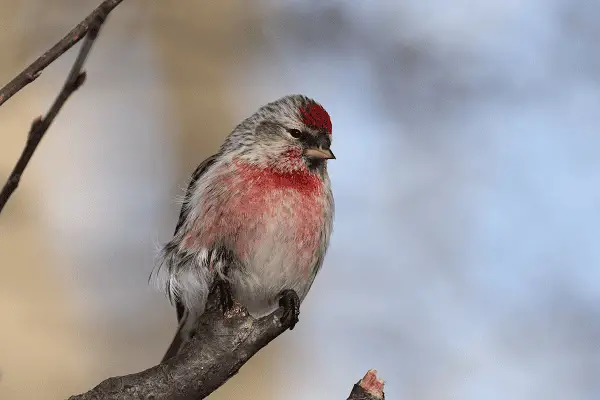
8. Red Crossbill
- Scientific name:
- Life span: 8 years
- Length: (14-17 cm)
- Weight: 1.4 oz
- Wingspan: (25-27 cm)
The Red Cross bill has a special crossed bill. It’s another finch you might see in Illinois during certain years. These birds are great at getting seeds out of conifer cones. They come to Illinois when they need to find food.
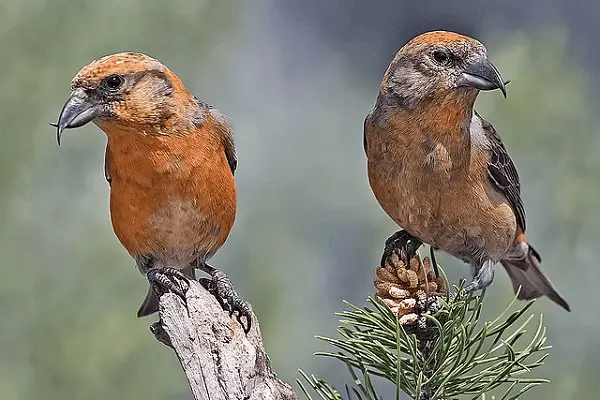
Seeing these finches in Illinois is thrilling for birdwatchers. They are special and fun to watch. Their unpredictable movements and changing numbers make seeing them exciting. It adds mystery and fun to winter bird-watching.
Check Our Previous Articles:
9. Hoary Redpoll
- Scientific name: Acanthis hornemanni
- Life span: 6 years
- Size: (12-14 cm)
- Weight: (11-20 g)
- Wingspan: (22-23 cm)
If you’re into birdwatching in Illinois, you might see the rare Hoary Redpoll. This small finch lives in the harsh Arctic tundra of North America, Europe, and Eastern Asia. It’s hard to spot, but the Hoary Redpoll is a beautiful bird. It has a brownish-gray back, a small yellow bill, and a white belly with light streaks. Male Hoary Redpolls even have a hint of red on their chests.
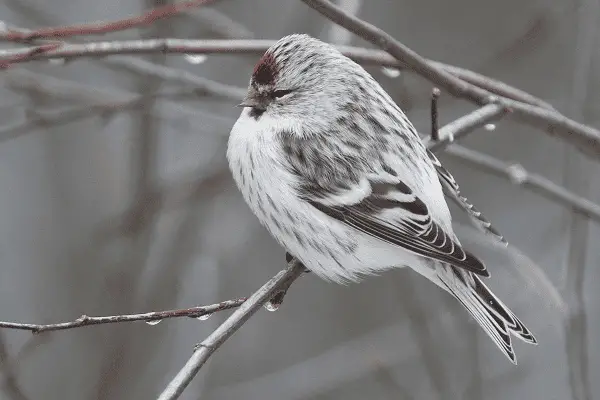
Appearance and Identification
The Hoary Redpoll stands out with its unique look. Its brownish-gray back and white belly with light streaks make it different from other finches. The small yellow bill is another distinctive feature. Male Hoary Redpolls have a touch of red on their chests, but it’s hard to see in the wild.
Range and Behavior
These finches live in the harsh Arctic tundra during the summer. In winter, some may come south, but they rarely go far into the U.S. Except during “irruption” years when food is scarce in the Arctic. During these times, areas like Illinois might see more Hoary Redpolls.
Hoary Redpolls are agile birds, often hanging upside down to eat small seeds from trees and weeds. They mainly eat small seeds, but also insects and buds. These finches are well-suited to the tough Arctic environment.
Attracting Finches to Your Feeders
If you love birds in Illinois, you can draw finches to your yard with the right feeders and garden. Finches like the American Goldfinch, House Finch, and Pine Siskin go for high-energy seeds. These include black oil sunflower seeds, nyjer, and millet. Adding native plants that have seeds, berries, and insects makes your garden more welcoming for these birds.
Offering a steady food supply and a varied garden can help you see many finch types in your yard. Finches prefer fresh, black seed-like thistle and won’t eat the old seeds. So, keep your feeders clean and filled with the right seeds.
With some effort, you can make your yard a finch paradise. Enjoy watching these colorful birds all year by meeting their needs and likes. Creating a bird-friendly space will amaze you with the beauty of these Illinois finches.
Frequently Asked Questions:
Q1. Are finches native to Illinois?
Yes, several finch species are native to Illinois, such as the American Goldfinch and the Purple Finch.
Q2. Do finches stay in Illinois for the winter?
Yes, some finch species, like the American Goldfinch, stay in Illinois throughout the winter months.
Q3. Where are finches most commonly found?
Finches are commonly found in various habitats across Illinois, including woodlands, suburban areas with bird feeders, and open fields.
Q4. What kind of bird is redheaded in Illinois?
In Illinois, the Red-headed Woodpecker is a bird with a distinct red head, often seen in wooded areas and forests



